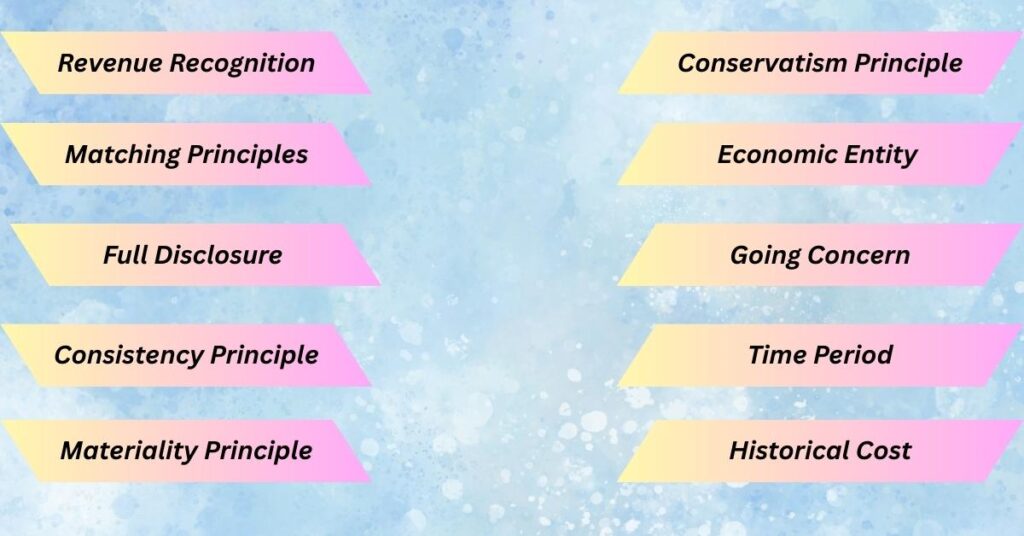10 Fundamental Accounting Principles Every Business Owner Must Know
Understanding accounting principles is very important for any entrepreneur or businessman who wants to keep accurate and precise financial records, make sound financial decisions, and ensure compliance with regulatory requirements. The Generally Accepted Accounting Principles (GAAP) establish the structure for accounting reporting in the US, creating a standardized system that ensures conformity and transparency in every business transaction.

Whether you’re a founder of a start-up business, a small business owner, or running an expanding enterprise, these basic accounting principles will guide you through the detailed domain of financial management. These accounting principles are not just ideas – they are hard rules that have a direct influence on how you account for transactions, arrange financial statements, and report your business’s financial condition to stakeholders, investors, and regulatory bodies.
In this detailed guide, we’re going to master the 10 most significant accounting principles. Every business owner ought to know them and why they matter in reporting a business’s transactions. Generally accepted accounting principles are helpful in ensuring the accuracy of financial statements of businesses and comfort of financial reporting with generally accepted accounting principles.
If you understand these accounting principles well, you will be in a better position to work with accountants, be able to analyze financial reporting, and make informed financial decisions. Each element of accounting principles plays a major role in maintaining the accuracy of your financial reports as well as making certain that your business operations comply with the generally accepted accounting principles.
Suppose you understand these basic concepts of accounting principles. In that case, you’ll be in a position to work with accountants effectively, interpret financial reports, and make informed business decisions based on proper financial information.
Generally Accepted Accounting Principles (GAAP)
Let’s dive into the depths of every element of accounting principles in order to get a full grasp that will help us perform every activity of the business according to these accepted principles.
Revenue Recognition Principle
The principle of revenue recognition is the most basic of accounting principles that speaks to how and when companies should report revenue in their financial reports. Under the principle, the revenue must be recognized if it is earned, even if payment has not yet been made. Thus, revenue is earned for when goods and services are delivered or rendered, not when there is a receipt of cash.
For example, suppose your consulting company completes a project in December but receives payment in January of next year. In that case, the revenue has to be recorded in December when the service was performed. This principle prevents companies from manipulating their accounts by managing cash receipts. It ensures that financial statements reflect the actual performance of the company during specific periods.
The principle of revenue recognition is especially relevant for companies that sell on credit terms, offer continuous services, or possess long-term contracts. It enables the establishment of a clear image of when value is created and transferred to customers, which renders financial statements more informative and consistent across various periods.
Matching Principle
The matching principle dictates that companies should expense when and where they help generate the revenue. This principle helps ensure that financial statements accurately capture the correspondence of cost and benefit, presenting a better picture of profitability and operating efficiency. Without the matching principle, there is no way to know the real cost of generating revenue during any period.
For example, take a retail company that buys merchandise in November but sells the items in December. According to the matching principle, the cost of goods sold must be recorded when the revenue from the sales is recognized in December, not when the merchandise was acquired in November. This gives a direct relation between the amount of revenue received and the costs borne to earn the revenue.
The principle of matching goes beyond direct expenses to encompass indirect charges like depreciation, insurance, and advertising expenses. For example, suppose a business pays a year’s worth of an advertising campaign in one payment. In that case, the expense should be allocated over the twelve months it is intended to cover, not all charged to the payment month. This keeps each period’s profitability more accurately represented.
Full Disclosure Principle
The full disclosure principle requires that firms make all material information available that could influence the judgments of the users of financial statements. By doing so, there is transparency as well as facilitating stakeholders to make decisions using complete and accurate information about the financial performance and position of the company. Material information includes anything that would likely influence an investor’s or a creditor’s judgment of the company.
Examples of such items that need to be disclosed are pending lawsuits, material subsequent events, changes in accounting principles, and any unusual and non-recurring items that may affect future performance. An example is if a company has a pending lawsuit that will result in significant financial liability, then this item must be disclosed in the financial statement footnotes. However, the outcome cannot be determined.
The full disclosure principle also covers accounting techniques and estimates employed in financial statement preparation. Companies have to disclose clearly their accounting policies, method of depreciation, method of inventory accounting, and material assumptions or estimates. This disclosure helps users to understand how financial statement numbers were calculated and to assess the quality of information presented.
Consistency Principle
The consistency principle requires firms to use the same accounting techniques and methods from one accounting period to another unless there is a strong justification for a change. The principle provides similar financial statements over the periods, which allows stakeholders to identify trends, track performance, as well as make effective comparisons between accounting periods.
For instance, if a company elects to use the straight-line method of depreciation in its initial year of operation, it should then continue so long as no changes are merited. In case a change is envisioned, the company ought to properly disclose the change and depict its effects on the financial statements so that the users may know how the adjustment impacts comparability.
Consistency does not imply that accounting approaches can never be altered – it merely demands that changes occur for appropriate business purposes and are adequately disclosed. Suitable reasons for changing accounting approaches may involve new accounting rules, modifications to business activities, or the implementation of approaches that better describe the firm’s financial truth. The necessity is to ensure that any changes are divulged and do not deceive financial statement users.
Materiality Principle

The materiality principle enables companies to adopt simpler accounting treatment for those things that are so small that they would not affect the actions of prudent users of financial statements. The materiality principle accepts the fact that absolute accuracy in accounting is not practical or required in immaterial quantities, so companies can concentrate their resources on those things that really matter.
Materiality is generally evaluated quantitatively and qualitatively. Quantitatively, an item may be deemed immaterial if it accounts for less than 5% of net income or total assets. Qualitative considerations, though, are also significant – amounts as small as these could be material if they involve managerial compensation, covenant compliance on loans, or other sensitive topics.
Let’s look at an example, a major company may treat the acquisition of office supplies as an expense immediately instead of accounting for them as assets and then expensing them over time as they are consumed. Although this treatment technically does not conform to strict accounting principles, the amounts themselves are normally so minor compared to the company’s overall activities that the simplified method does not mislead anyone and conserves administrative effort.
Conservatism Principle
The conservatism concept, or prudence concept, instructs accountants to select the most conservative accounting treatment where there is uncertainty in order not to overvalue assets and revenues. This ensures that financial statements do not present an unrealistic picture of a company’s finances, safeguarding investors and lenders from making decisions when their numbers are inflated.
In applying the principle of conservatism, accountants must recognize losses as early as they are probable, but gains only when realized. For instance, if a firm’s inventory might have gone out of date, the potential loss must be accounted for right away. Yet, if the firm is likely to gain from an awaiting contract, such a gain must not be accounted for until the contract is signed and the revenue is received.
This principle is reflected in numerous accounting methods, including the lower-of-cost-or-market rule for inventory valuing and the need to set up allowances for doubtful accounts. Conservatism prevents financial position from being overstated, but it has to be balanced by the requirement for fair and accurate representation – too much conservatism can be as misleading as too much optimism.
Economic Entity Principle
The economic entity principle mandates that business transactions must be segregated from personal transactions of the business proprietors. This segregation is necessary for accurate financial record-keeping and ensuring that the financial statements only reveal the activities of the business and not the personal financial activities of the owners or managers.
Under this principle, a company is treated as a distinct economic entity whether or not the business is a sole proprietorship, partnership, or corporation. Its books of account must be kept separately from those of its owners, irrespective of the type of business. This implies that personal expenditures cannot be listed as business expenditures, and company assets cannot be mixed up with personal assets.
For instance, if an owner charges personal groceries on the company credit card, such a transaction will have to be accounted for as a withdrawal or a loan by the business and not as an expense of the business. Likewise, suppose an owner injects their own money into the business. In that case, this has to be accounted for as a capital contribution and distinguished from the business revenue. This distinction is absolutely important for proper financial reporting as well as tax purposes.
Going Concern Principle
The going concern principle informs us that a business will remain operational in the foreseeable future unless indicated otherwise. This presumption supports most accounting practices and influences how assets and liabilities are valued and reported in financial statements. Without such an assumption, the assets would have to be valued at liquidation value instead of being valued at their price in continuing operations.
Under the going concern assumption, companies can carry assets at historical cost and amortize them over their useful lives, instead of writing them down to their current sale value. This is reasonable because most firms purchase assets to use them in operations, not sell them right away. In the same way, long-term obligations can be carried at face value instead of current settlement value.
But if there is reasonable doubt regarding a company’s going concern status – say, due to extreme losses, difficulties in meeting its cash obligations, or other financial issues – then this should be disclosed on the financial statements. In these instances, other valuation methods might be required, and the financial statements could need to be prepared on a liquidation rather than a going concern basis.
Time Period Principle
Time period principle, or periodicity principle, stipulates that business activities should be reported for certain time periods, say monthly, quarterly, or yearly. This principle allows stakeholders to compare performances in different periods as well as facilitates financial information to be more valuable for decision-making. It is not possible to identify trends or do meaningful comparisons were it not for standardized reporting periods.
This concept requires the application of accrual accounting and the application of several estimation methods. Because business activities are ongoing but reporting is required at regular intervals, accountants need to estimate when revenues and expenses need to be recognized. Utility costs that last for several months, for instance, need to be assigned correctly to each accounting period, and depreciation costs need to be estimated to allocate the cost of assets to the periods benefiting from their usage.
Time period principle also makes it compulsory for companies to post numerous adjusting entries at the closure of every accounting period to match revenues and expenses to their respective periods. Such adjustments could include accruing unpaid expenses, deferring prepaid expenses, and recognizing earned but unbilled revenue. The process makes sure that every period’s financial statements show the business activity that took place during that respective period.
Historical Cost Principle
Historical cost principle demands that assets should be valued at their initial purchase price and kept at such cost in most cases during their useful life span, aside from any adjustment like depreciation or impairment. The principle offers objectivity and verifiability to financial reports since historical costs are derived from actual transactions and not from subjective assumptions of current value.
According to this principle, if an entity buys equipment costing $50,000, it will be posted for $50,000 even if its market value at a later date increases or decreases. Though the equipment will be depreciated over its useful life, the initial cost basis doesn’t change unless there is a major impairment or the asset is disposed of. This is done to ensure consistency and minimize opportunities for financial statement manipulation.
Nevertheless, the historical cost principle is limited, especially in inflation or times of dramatic changes in the market. Historical cost assets will not represent their current economic value, and as such, might render financial statements less useful for decision-making. Nevertheless, historical cost is still the main foundation for asset valuation due to its ability to give reliability and comparability, which would be hard to obtain through ever-changing market-based valuations.
Business Applications

It is important to grasp these accounting principles for successful business operation. They form the basis for keeping proper books of accounts, presenting useful financial statements, and adhering to regulatory demands. Entrepreneurs who comprehend these principles can negotiate with their accountants more effectively, make better financial decisions, and evade expensive missteps.
Accounting principles also have significant applications in business planning and analysis. For instance, being aware of the revenue recognition principle enables accurate cash flow forecasting. In contrast, the matching principle allows for more accurate profitability analysis. The consistency principle allows the trends in performance to be recognized and analyzed over time, facilitating strategic decision-making.
For companies that require investment or credit, following these principles is essential to upholding credibility in lenders’ and investors’ eyes. GAAP-based financial statements offer the transparency and integrity that external parties need to make funding decisions.
Key Points
The salient features of these fundamental accounting principles are as follows:
- The revenue recognition principle: States that revenue should be recorded as soon as it is made rather than when cash is received.
- The matching principle: States that expenses should be matched to the revenue they produce within the same time frame.
- Full Disclosure Principle: Provide all relevant facts that can influence a user’s choice.
- Consistency Principle: Unless a change is warranted, use the same accounting procedures from one period to the next.
- Materiality Principle: Highlight issues that are important enough to influence choices.
- Conservatism Principle: Choose treatments that are least likely to inflate assets and income in accordance with the conservatism principle.
- Economic Entity Principle: Keep personal and business dealings apart.
- Going Concern Principle: Unless there is proof to the contrary, assume that the business will continue to function indefinitely.
- Time Period Principle: Document company operations for predetermined, consistent time frames.
- Historical Cost Principle: Maintain the cost basis and record assets at their original purchase price.
Conclusion

These 10 fundamental accounting principles serve as the backbone of the best financial reporting and management. These principles are not just theoretical; rather, they are practical instruments that help entrepreneurs maintain accurate records, make wise selections, and develop trust with all stakeholders. You can create a solid financial management foundation for your company by understanding and implementing these generally accepted accounting principles on a regular basis.
Generally accounting principles complement one another to form an all-inclusive system of financial reporting that is accurate, consistent, and transparent. Understanding these concepts will drastically enhance your capacity to comprehend and manage your company’s financial matters effectively.
Remember that while accounting principles are useful guidelines, the complexity of modern business typically requires expertise in terms of knowledge to be applied in order to carry them out effectively. Working together with expert accountants who understand these concepts and can help you implement them effectively is crucial for the long-term success of your company.
As your company grows and develops, these accounting principles will continue to serve as your guide to transparency and financial honesty. Each principle should be read and studied, and if you need help applying it to your company situation, don’t be afraid to seek professional advice. Building a solid financial foundation on these tenets will help your company develop and succeed in the years to come.
Related Articles:
- Fixed Index Annuities: Your Way to Financial Confidence and Security
- QuickBooks Excellence: Transform Your Accounting Game with These Powerful Techniques
- Inbound vs. Outbound Marketing: The Great Debate That’s Reshaping Business Strategy
- How to Master Balance Sheet Analysis? Expert Guide with Examples
- Income Statement Formats: Complete 2025 Guide with Examples and Structure
- What Are Current Liabilities And Why They Matter For Financial Success
- Current Assets Essentials: Elevate Your Financial Management Game
- Remote Payroll Jobs: Your Gateway to Flexibility and Financial Growth
- Payroll Advance: Powerful Ways to Enhance Workplace Morale
- Powerful Mobile Marketing Strategies You Must Try
- Best Marketing Tools In An Advertising Plan
- Mastering Revenue Expenditure for Business Success
- Market Research And Its Importance: A Comprehensive Review
- What You Should Know? Notes Payable And Accounts Payable
- Digital Marketing And Strategies: A Comprehensive Review with Examples
- Are Annuities the Best Investment for a Bright Future? A Comprehensive Analysis
- Understanding Capital Expenditure: Definition, Significance, and Its Association in Financial Decision-Making
- Difference Between Accounting And Finance: A Proven Comprehensive Guide For Beginners
- Difference between Annuity due and Ordinary Annuity
- Essential Accounting Software for Small Enterprises
- 5 Best Software For Small Business Accounting







